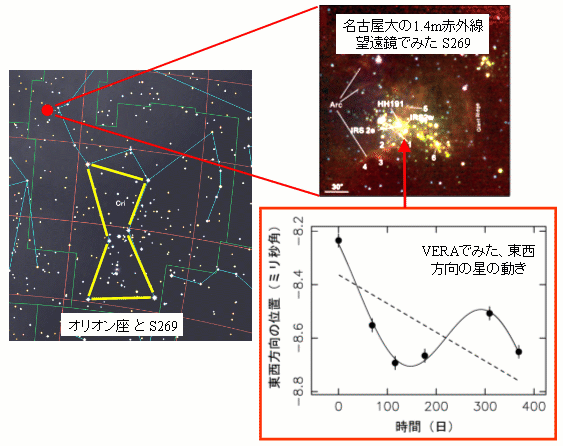News release from Mizusawa-VERA-observatory
Record-breaking astrometric precision achieved with VERA
VERA (VLBI Exploration of Radio Astrometry) has demonstrated its high capability
of precise astrometry by breaking the world record of the largest distance
measured by means of trigonometric parallax as well as by providing the
best distance measurement for Orion KL, one of the most important Galactic
objects.
S269 (Sharpless 269) is a massive star forming region toward constellation Orion. VERA has successfully measured its trigonometric parallax of 189 +/- 8 micro-arcsecond (1 micro-arcsecond corresponds to 1/3,600,000,000 degree). This is the smallest parallax ever measured, corresponding to a source distance to 17,250 light year. This record-breaking measurement nearly doubled the reach of parallax distance (the previous record was 9050 light year for Sco X-1 by Bradshaw et al. 1999). Based on the VERA observations, Galactic rotation speed at the position of S269 is also determined precisely. It turned out that the rotation speed there is larger than that expected from the stellar distributions in the Galaxy, indicating existence of large amount of dark matter. This study will be published in Publication of Astronomical Society of Japan, 2007 October issue (Honma et al. 2007).

Figures : (left) Location of S269 in Constellation Orion. (top right) an
infra-red image of S269 taken with Nagoya-university 1.4m telescope. (bottom
right) the east-west motion of S269 maser source (since Nov 2004), showing
parallax (1-year modulation) of 189 micro-arcsecond.
Orion KL (Kleinmann-Low object) is at the core of Orion star forming region
and one of the most important objects in the Galaxy to explore how massive
stars form. VERA has successfully detected its parallax and obtained the
source distance to be 1425 +/- 62 light year. This distance is consistent
with a previous estimate by Genzel et al. (1981) of 1565 +/- 260 light
year but the first one based on trigonometric parallax and the best distance
of Orion KL ever obtained, which improved the precision by a factor for
4. This study will be published in Publication of Astronomical Society
of Japan, 2007 October issue (Hirota et al. 2007).

Figures: (left) a Subaru image of Orion-KL region. (right) Absolute motion
of maser source in Orion-KL, showing parallax and proper motion.
back to VERA's homepage

